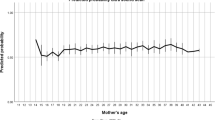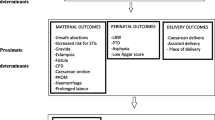Abstract
Pregnancy in adolescence has been and continues to be a problem in public health. The purpose of this study was to investigate obstetric outcomes of adolescent pregnancies in Samsun, Turkey. A cross-sectional study was conducted between January 1 and December 31, 2004, at 3 hospitals in Samsun, Turkey. Of the 10,100 women who gave birth during this period, 357 (3.5%) were 18 years of age or younger; these patients were included in the study. Participants with a history of any chronic disease were excluded. Data were provided as median values (minmax) and percentages. In this study, the rate of birth for females 18 years or younger was found to be 35 per 1000. The median age of participants was 18 (14–18) years. The prevalence of cesarean section was calculated at 55.7%. Prevalences of lowbirthweight infants, preterm delivery, and eclampsia/preeclampsia were recorded as 44 (12.3%), 34 (9.5%), and 30 (8.4%) cases, respectively. Although the stillbirth rate was determined to be 1.7%, no congenital deformity was noted in infants, and none of the mothers died. The cephalopelvic disproportion rate was 5.9%, and only 2 adolescents experienced abruptio placentae. To reduce the occurrence of adolescent childbearing, pregnancy intentions must be assessed in multiple ways. Information/education may provide benefit to those female adolescents with inconsistent pregnancy intentions.
Similar content being viewed by others

References
World Health Organization.Adolescent Pregnancy: Issues in Adolescent Health and Development. Geneva, Switzerland: World Health Organization, Department of Child and Adolescent Health and Development; 2004.
United Nations International Children’s Emergency Fund [home page on the Internet]. Fertility and family planning [updated July 5, 2005]. Available at: www.unicef.org/specialsession/about/ sgreport-pdf/10_Fertility Family Planning D7341 Insert_English.pdf. Accessed July 12, 2005.
United Nations International Children’s Emergency Fund [home page on the Internet]. Facts for life-PMS144.qrk [updated July 5, 2005]. Available at: www.unicef.org/ffl/pdf/factsforlifeen-part2.pdf. Accessed July 12, 2005.
Hamilton BE, Martin JA, Sutton PD. Births—preliminary data for 2003.Natl Vital Stat Rep. 2004; 53:1–17.
United Nations International Children’s Emergency Fund (UNICEF).The State of the World’s Children, 1998. New York, NY: UNICEF USA; 1999.
Hacettepe University Institute of Population.The 2003 Turkey Demographic and Health Survey. Ankara, Turkey: Hacettepe University Institute of Population; 2003.
Aksit S, Turpculu A. Trends in teenage pregnancy in Turkey.Int J Gynecol Obstet. 2003;81:55–56.
Ozalp S, Tanir HM, Sener T, Yazan S, Keskin AE. Health risks for early (≤19) and late (≥35) childbearing.Arch Gynecol Obstet. 2003;268:172–174.
State of the World’s Mothers. Report, May 2004 [updated April 3, 2005]. Savethechildren.org [home page on the Internet]. Available at: http://www.savethechildren.org. Accessed May 28, 2005.
World Health Organization.Reduction of Maternal Mortality: A Joint WHO/UNFPA/UNICEF/World Bank Statement. Geneva, Switzerland: World Health Organization; 1999.
Kushwaha KP, Rai AK, Rathi AK, Singh YD, Sirohi R. Pregnancies in adolescents: fetal, neonatal and maternal outcomes.Indian Pediatr. 1993;30:501–505.
Abi-Said D, Annegers JF, Combs-Cantrell D, Frankowski RF, Willmore LJ. Case-control study of the risk factors for eclampsia.Am J Epidemiol. 1995;142:437–441.
Jolly MC, Sebire N, Harris J, Robinson S, Regan L. Obstetric risks of pregnancy in women less than 18 years old.Obstet Gynecol. 2000;96:962–966.
Rosengard C, Phýpps MG, Adler NE, Ellen JM. Adolescent pregnancy intentions and pregnancy outcomes: a longitudinal examination.J Adolesc Health. 2004;35:453–461.
King JC. The risk of maternal nutritional depletion and poor outcomes increases in early or closely spaced pregnancies.J Nutr. 2003;133:1732–1736.
Mahfouz AA, El-Said MM, Al-Erian RA, Hamid AM. Teenage pregnancy: are teenagers a highrisk group?Eur J Obstet Gynecol Reprod Biol. 1995;59:17–20.
Towne B, Czerwinski SA, Demerath EW, Blangero J, Roche AF, Siervogel RM. Heritability of age at menarche in girls from the Fels Longitudinal Study.Am J Phys Anthropol. 2005;128:210–219.
Otterblad OP, Haglund B, Ringback Weitoft G, Cnattingius S. Premature death among teenage mothers.BJOG. 2004;111:793–799.
Abou ZC, Royston E.Maternal Mortality: A Global Fact Book. Geneva, Switzerland: World Health Organization; 1991.
Senanayake P. Adolescent fertility. In:Health Care of Women and Children. Oakland, Calif: Third Party Publishing Company; 1990:470–475.
Moerman ML. Growth of the birth canal in adolescent girls.Am J Obstet Gynecol. 1982;143: 523–528.
Harfouche JK, Verhoestrate LJ. Child Health. The State of Child Health in the Eastern Mediterranean Region, Alexandria. Cairo, Egypt: World Health Organization Regional Office for the Eastern Mediterranean; 1983:131–163(EMRO Technical Publication, No. 9).
Bozkaya H, Mocan H, Usluca H, Beser E, Gumustekin D. A retrospective analysis of adolescent pregnancies.Gynecol Obstet Invest. 1996;42:146–150.
Barda G, Arbel-Alon S, Bernstein D, Zakut H, Menczer J. Pregnancy and delivery in a group of Israeli teenagers: a case-controlled study.Clin Exp Obstet Gynecol. 1998;25:32–35.
Lao TT, Ho LF. The obstetric implications of teenage pregnancy.Hum Reprod. 1997;12:2303–2305.
Pal A, Gupta KB, Randhawa I. Adolescent pregnancy: a high risk group.J Indian Med Assoc. 1997;95:127–128.
Chandra PC, Schiavello HJ, Ravi B, Weinstein AG, Hook FB. Pregnancy outcomes in urban teenagers.Int J Gynecol Obstet. 2002;79:117–122.
Amini SB, Catalano PM, Dierker LJ, Mann LI. Births to teenagers: trends and obstetric outcomes.Obstet Gynecol. 1996;87:668–674.
Ziadeh S. Obstetric outcomes of teenage pregnancies in North Jordan.Arch Gynecol Obstet. 2001;265:26–29.
Khwaja SS, Al-Sibai MH, Suleiman A. Obstetric complications of pregnancy in adolescence.Acta Obstet Gynecol Scand. 1986;65:57–61.
Author information
Authors and Affiliations
Rights and permissions
About this article
Cite this article
Canbaz, S., Sunter, A.T., Cetinoglu, C.E. et al. Obstetric outcomes of adolescent pregnancies in Turkey. Adv Therapy 22, 636–641 (2005). https://doi.org/10.1007/BF02849957
Issue Date:
DOI: https://doi.org/10.1007/BF02849957



